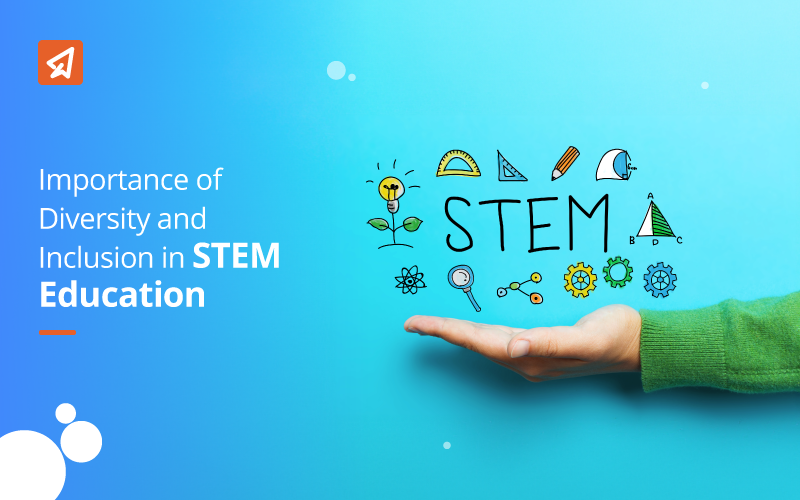Importance of Diversity & Inclusion in STEM Education

Diversity and inclusion are among the defining characteristics of a progressive society. And when it comes to education, diversity, and inclusion hold the key to creating a future-ready generation for our society. Unfortunately, most recent surveys still show bias and inequity in most branches of education, especially STEM education.
Data from the Pew Research Centre shows that the STEM workforce predominantly comprises male professionals. For example, only 25% of computer jobs and 15% of engineering jobs are done by women. The STEM fields stand for science, technology, engineering, and mathematics. Diversity and inclusion in these fields can help bring new ideas, better innovation, and progress to the world. Therefore, this article will discuss the importance of diversity and inclusion in STEM education and highlight some strategies for schools to work in this direction.
What is STEM Education?

STEM education follows a transversal approach wherein science, technology, education, and mathematics are taught to develop a student’s creativity, critical thinking, and logical reasoning skills. To encourage students to brainstorm and research classroom concepts, STEM education relies on project-based learning wherein students apply their concepts to solve simulated real-life problems.
STEM education emphasises the interconnectedness of science, technology, education, and mathematics. This approach to learning is also heavily focused on applying classroom concepts, skills, and knowledge to solve real-world problems. Incorporating STEM education enables educators to prepare students for the 21st-century workforce. The skills and knowledge students gain in a STEM program will be valuable in any career.
Role of Diversity & Inclusion in STEM Education
Diversity and inclusion are essential aspects of every education system. Inclusion creates a learning environment where students from all backgrounds and learning abilities feel welcome, included, and supported. A diverse and inclusive STEM education system is built when diverse students learn together and pursue their STEM aspirations despite their unique backgrounds or learning abilities.
Diversity and inclusion encompasses differences in gender, race, ethnicity, and socioeconomic status. Cultivating diversity and inclusion in the STEM education system paves the way for diverse and inclusive workplaces in the future by shaping the right mindsets from a young age.
Benefits of Diversity & Inclusion in STEM Education
-
Innovation & Creativity
STEM education encourages students to collaborate on projects and presentations. When students from diverse backgrounds and mindsets come together to work as a team, they share their unique approaches and insights. Discussing diverse perspectives enables STEM students to think outside the box, encouraging innovation and creativity.
-
Equitable Representation & Societal Benefits
Historically, several minorities and ethnicities are underrepresented in STEM fields. By encouraging diversity and inclusion in STEM education, we can give students from disadvantaged backgrounds an equal opportunity to learn and grow in the STEM fields. It can help build a more equitable society for the future generations. Tapping into the talents of these underrepresented groups can also benefit society by creating a diverse STEM workforce. It allows humankind to achieve more equitable solutions to global STEM challenges.
-
Attracting Top Talent & Economic Growth
Research has shown that a diverse workforce can help organisations attain better business growth and outperform their less-diverse counterparts in profitability and innovation. Encouraging diversity and inclusion in the STEM education landscape will help attract and retain the topmost talent. A diverse STEM workforce can drive innovation and improve economic growth.
-
Overcoming Global Challenges
The STEM workforce is important in addressing global challenges like climate change, economic disparities, and sustainable development. Diversity and inclusion in STEM education can help create a diverse STEM workforce with professionals from different backgrounds, enabling them to approach global challenges with different perspectives. Tackling global challenges with unique experiences and insights from a diverse workforce can help the world find culturally sensitive and sustainable solutions to global challenges.
-
Inspiring Future Generations
Bringing diversity and inclusion in STEM education can help create diverse youth icons in STEM fields. These diverse role models can help inspire young students from underrepresented groups to pursue STEM education. Motivating students from diverse backgrounds to follow a STEM career path can pave the way for a diverse and inclusive STEM workforce.
-
Ethical Responsibility & Social Justice
Equitable access to STEM education is an essential moral responsibility and a matter of social justice. It can help us create a global culture that respects diversity and emphasises inclusion. Fostering STEM talents from all walks of life by offering equal opportunities – will allow everyone to achieve their true potential and contribute to knowledge and innovation.
In essence, by cultivating a diverse and inclusive learning environment, we can unleash the full potential of our STEM workforce and create a world where everyone can contribute to advancing science, technology, engineering, and mathematics.
Role of Educators in Creating an Inclusive and Diverse STEM Education Environment
-
Culturally Responsive Teaching
Culturally Responsive Teaching or CRT is a pedagogical technique designed for effective learning in a culturally diverse classroom. This approach acknowledges and respects the cultural backgrounds of all students in the class and tries to incorporate their diverse perspectives into the learning and instruction process. Using CRT in STEM education can make the learning process more engaging and relatable for students from underrepresented groups. Some real-life examples of educators using CRT in STEM education are –
- Science teachers incorporate knowledge from indigenous cultures when teaching botany or zoology.
- Mathematics lessons that use real-world examples to explain concepts in geometry or calculus.
- When learning technology, teachers can cite examples of innovation from diverse communities to illustrate the concepts.
-
Keep High Expectations & Offer Support
Irrespective of the education model, teachers must always keep high expectations from students. In STEM education, teachers provide rigorous coursework and challenging assignments to enable students to fulfil their aspirations. However, offering the required support to help students meet high expectations is also essential. Support like mentorship, tutoring, and individualised instruction can help students from diverse backgrounds or different learning abilities keep up with the rest of the class. Some examples are –
- Sharing additional resources and practice materials for students struggling with mathematics.
- Tutoring sessions in science for students who need extra help with projects.
- Forming project groups of students from underrepresented communities
-
Mentorship & Role Models
Finding STEM role models for students from underrepresented backgrounds can help inspire them to pursue their STEM aspirations. Teachers should organise talks and workshops where mentors and role models can interact with students to offer support and motivation. Here are some real-life examples –
- Partnering with female STEM professionals to mentor female STEM students
- Forming a Math Club or Science Cub wherein STEM professionals from underrepresented communities can connect with STEM students from similar backgrounds to offer support and mentorship.
- Science teachers can invite STEM alums from underrepresented groups to discuss their career stories with the class to inspire students.
-
Early Exposure Advantage
Early exposure to STEM education can help dispel prejudice or misconceptions about STEM fields in learners’ minds. It can enable them to keep an open mind and supportive attitude towards students from diverse backgrounds. Eventually, it will help create an equitable opportunity for everyone to pursue STEM careers. Schools can also incorporate STEM in early learning by encouraging students to participate in STEM competitions. Some examples are –
- Incorporating STEM in pre-school by organising activities with blocks, coding robots or nature excursions.
- An annual STEM fair for students to showcase their STEM projects
- Encourage students to participate in STEM competitions. Extramarks holds an annual STEM competition and awards winners with scholarships to pursue STEM education.
-
Addressing Biases & Stereotypes
Bias and stereotypes prevent students from diverse backgrounds from pursuing their STEM aspirations. Educators can play a vital role in addressing these biases and stereotypes by improving awareness and creating an inclusive learning environment. This step is essential towards building a diverse and inclusive STEM education ecosystem. Some examples are –
- School districts conduct bias awareness training for educators to make them introspect and address any subconscious bias they have.
- Science teachers can mediate a group discussion about stereotypes and biases in STEM fields.
- A class welcomes a new student from a diverse background with a discussion about the work of an accomplished STEM professional of similar roots.
-
Faculty & Staff Training
Before schools can expect students to discard their prejudices and contribute towards an inclusive learning environment, it is critical to train the faculty and staff about inclusion. All new teachers and staff members should be trained extensively about diversity and inclusion best practices. They play a vital role in creating a welcoming and supportive STEM education environment for students from diverse backgrounds.
-
Collaboration with the Community
Partnering with the community can help create a supportive environment for STEM learning and encourage students from diverse backgrounds to pursue STEM education. Teachers can organise awareness programs and career fairs with community organisations to provide resources and information about STEM programs. Some examples are –
- Organising a STEM night wherein families can participate in STEM activities together.
- Science teachers can partner with museums to offer STEM workshops for students and their families.
- Teachers and school leaders can initiate a STEM after-school program to support students from diverse backgrounds and underrepresented groups.
-
Diverse Learning Activities
Providing students with various learning activities like field trips, hands-on experiments, project-based learning, and online learning can help cater to diverse learning needs. It can elevate the learning environment in your class to make it inclusive and engaging. For example –
- Using lectures, demonstrations, and group projects to improve student engagement in science lessons.
- Mathematics teachers can assign equivalents of real-life problems to students to apply their knowledge and concepts.
- Filed trips organised by technology faculties to manufacturing units to understand the engineering behind things we use in everyday life.
-
Inclusive Classroom Environment
Nurturing an inclusive and welcoming classroom environment where every student feels respected and valued can help students from underrepresented groups gain the confidence to participate. Educators are responsible for creating an environment where students feel safe and confident to experiment, make mistakes, ask questions, and discuss new ideas. Some ideas for educators are –
- Use neutral language in class and avoid assumptions based on a student’s background or learning abilities.
- Encouraging students to share their diverse perspectives in a mathematics project team.
- Offering the opportunity to build and experiment in an engineering class.
-
Celebrate Diversity & Inclusion
Recognising and celebrating the achievements of all students – especially those from underrepresented communities- can encourage everyone. Educators can foster an inclusive classroom environment by organising STEM rewards, creating a STEM wall of fame, and highlighting students’ achievements.
- Organise a district-level exhibition to showcase STEM work done by students from underrepresented communities.
- Highlight the diversity and inclusion aspect of your school culture on your website.
- Special symposiums for students from underrepresented communities to present their research to their seniors and peers.
-
Reflection & Improvement
Fostering a learning environment that promotes diversity and inclusion is a continuous effort. Educators must work towards improving diversity and inclusion in their classrooms every year by reflecting on their approach and identifying areas of improvement. This includes seeking feedback from students, colleagues, and community members. Some examples are –
- STEM teachers can conduct periodic surveys and interviews with students from underrepresented communities to seek feedback on teaching methods.
- Science teachers collaborate to share their best practices and innovative pedagogies when working with students from underrepresented groups.
- Schools organise professional development workshops for STEM teachers to encourage culturally responsive pedagogy while addressing implicit bias.
By implementing the strategies listed above, STEM educators can enhance diversity and inclusion in STEM education – thus giving the world a generation of diversified STEM workers. Teachers can experiment with different ideas to decide what works best for their students and the students of underrepresented communities in their schools.
Research shows that implementing strategies to improve diversity and inclusion works best in technologically enabled classrooms. Partnering with Extramarks can empower teachers to create a personalised instruction approach in STEM education – thus making it easier to include students from diverse backgrounds and learning abilities in their classroom.
Extramarks empowers your school to create smart classrooms where every student feels respected, valued, and engaged in the STEM learning process.
Learn MoreFAQs
-
Are STEM and STEAM different?
STEAM is an approach to education that includes science, technology, engineering, arts and mathematics. It is similar to STEM, except that it contains arts programs in their approach to education. The underlying philosophy of the STEAM approach is that including arts helps foster creativity and critical thinking.
-
What is STEM Literacy?
STEM literacy refers to the ability to understand science, technology, engineering, and mathematics topics and communicate meaningfully. STEM literates can identify problems in STEM fields and suggest solutions using STEM methodologies.
-
What is STEM Identity?
STEM identity refers to how a student or professional thinks of themselves in terms of STEM fields. Those who identify as scientists, mathematicians, engineers, or technologists are said to have a STEM identity. People with a strong STEM identity feel more confident in pursuing STEM education and professions.
-
Why is diversity important in STEM fields?
Diversity fosters innovation, brings different perspectives, and ensures a more comprehensive understanding of scientific and technological challenges.
-
What challenges do minority students face in STEM education?
Minority students often face challenges like biases, prejudice against their talents, lack of resources, and limited access to opportunities in STEM education.
-
How can educational institutions promote inclusivity in STEM Programs?
Educational institutions can promote inclusivity in STEM programs by making reforms in their approach to students from underrepresented communities, addressing biases in the minds of educators and administrators, and creating an inclusive curriculum.
Last Updated on August 31, 2024









